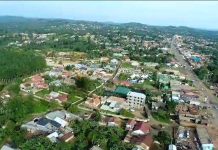Africa-Press – Uganda. The Uganda Local Government Association (ULGA) has delivered a gloomy forecast about the parish development model, noting that — its good intentions notwithstanding — a number of challenges abound.
The programme, which was rolled out in July, has already been dogged by a number of issues ranging from absence of parish chiefs in more than half of the parishes across the country to lack of parish development committees as well as parish SACCOs among others.
ULGA noted that before the introduction of the parish development model, local governments were grappling with the conceptualisation of the new programme-based budgeting approach.
The programme aims at transforming the budget from output-based to a more result-and performance-based approach.
In a policy brief titled ‘The Parish Development Model: Implications For Local Governments And Service Delivery In Uganda’, ULGA observed that the new model “raises a lot of questions” after Finance minister, Matia Kasaija’s “ministerial statement declared that [the] government is convinced about the fact that nothing can better guarantee inclusive growth and employment for Ugandans than equitable participation of more Ugandans in the monetised economy.”
ULGA also expressed doubt as to whether the model will be any different from the parish development plans (PDP) and the parish development committee (PDC) structures that were once famous in early 1990s to mid-2000.
The association said it is the same proposed governance structure that existed at that time.
Back then, each parish was headed by a parish chief who was mandated to support communities to develop PDP in a participatory process and also elect a PDC to ensure the implementation of the laid-out plan.
According to the parish development model concept, the transition period is planned to last at most two years. The model is to be operated under Saccos at the parish level.
ULGA, however, said key among the concerns, is the state of readiness of the districts to roll out this new model in the wake of weak governance structures.
The association is particularly concerned with parish chiefs, who are supposed to be the primary drivers of any government programme.
As of July, more than 5,000 parishes across the country did not have parish chiefs yet they are supposed to be the key focal persons in the implementation of the model. An implementation guideline issued by the Local Government ministry states that in accordance with Section 69 of the Local Government Act (1997), the parish chief will be responsible for ensuring implementation of district and government policies and programmes.
The local government association, however, said currently, districts do not have functional PDCs, which are supposed to provide oversight roles to the parish chief.
This is coupled with the absence of parish co-operative associations through which central government support will be channeled to enable households access the funds at a concessional interest rate.
Slow progress
According to ULGA, districts are equally concerned that funds already earmarked for programmes such as Youth Livelihood, Women Entrepreneurship and Emyooga will be channelled to finance this new model.
“The slow progress towards the full operationalisation of new administrative units is a clear signal that not all parishes in Uganda are set to benefit from the programme this financial year. Today, there are town councils and sub-counties that are yet to secure codes for funding purposes ,” the brief reads.
The association says while the government has over years been designing poverty alleviation programmes, the number of Ugandans slipping in poverty has increased from 8 million to 8.3 million, with the majority living in Busoga, Bukedi and Acholi sub-regions. “This calls for a review of the national planning process that must reflect the bottom-up approaches where communities are engaged in the identification of suitable and preferred interventions that are responsive to the drive against poverty,” it concludes.






